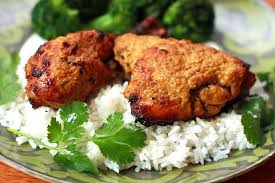2021 Paper 1: Sample Response 1 (Tandoori Food)
 One of the May 2021 Paper 1 examination texts was an article on tandoori cooking, published in The New York Times Magazine. You can find the article here (which, in the examination, ends at ‘or they will turn pasty during cooking’). The article is multimodal, containing a small image of tandoori food, and with a headline published in a font worth further consideration.
One of the May 2021 Paper 1 examination texts was an article on tandoori cooking, published in The New York Times Magazine. You can find the article here (which, in the examination, ends at ‘or they will turn pasty during cooking’). The article is multimodal, containing a small image of tandoori food, and with a headline published in a font worth further consideration.
The guiding question is this: Discuss how different features are used on this webpage to create an impression of Indian culture.
On this page (below) we have published one student's excellent work. Would it receive full marks? Probably. Could a student have written this in an examination? Probably not (it was not done under exam conditions).
Sample Guided Textual Analysis
![]() Guided Textual Analysis (Tandoori Food)
Guided Textual Analysis (Tandoori Food)
Guiding Question: Discuss how different features are used on this webpage to create an impression of Indian culture.
Paper 1: May 2021 (Food; India’s Soul Food)
If you imagine India or Indian food, the ideas that form in your mind will depend in large part on your own identity, preconceptions, and lived experience. As an Indian born in rural Kerala, my experiences of India are first hand. I have, you could say, an emic perspective – the view of an Indian ‘insider’. The article from The New York Times Magazine is not, I suspect, intended for someone like me, someone who has insight and whose view of India is complex and certainly far from romanticised. Since the meaning of any text is co-dependent on the identity of its reader, it is this understanding of ‘American readers’ that the writer, Julie Sahni, uses to construct, and you could say manipulate, New York Times readers’ impression of Indian culture. Readers of The Times are not, obviously, a homogenous group, but they are likely to share certain traits; they are likely to be well-educated, in good employment, and with a sense that they are urbane and cosmopolitan. Most likely, they will be or view themselves as liberal and tolerant, the kind of people who advocate for the enriching benefits of multiculturalism. Moreover, this article is published in The New York Times Magazine. Although I am uncertain, I would suggest this is part of a weekend edition of The Times, and thus readers may have more time for slow, relaxed reading. These are important understandings, because it is on this basis that Sahni is able to construct her sense of India and its culture.
The headline, ‘FOOD; INDIA’S SOUL FOOD’ is likely to be the first thing that the reader encounters, and it immediately establishes an impression of India. The font itself has a particular paralinguistic function that readers may recognise as somehow connotative of India, and slightly exotic or ‘otherly’. Indeed, it is this idea of a romanticised, faraway place, unfamiliar and un-American that is, in part, essential to Sahni’s construction of India. The headline appears simple. It is only four words. However, the semi-colon that separates the first mention of ‘food’ and ‘India’s’ asks the reader to pause momentarily. What is to be discussed – the reader does not fully know at this stage – is not ‘just food’; in fact, it is ‘India’s soul food’, the soul food of, quite probably, the most populous nation on Earth. Although Sahni certainly exoticizes India, she does this through an idiom that American readers will recognize. Thus, the notion of ‘soul’ draws upon both the Hindu sense of the soul as the essence of the individual inner-self, and also a more American sense that shares the sense of a person’s essence, but may also evoke a sense of cosy comfort.
The idea of ‘more than food’ is extended into the opening of the first paragraph. The declarative first sentence tells readers that ‘TO AN INDIAN FAMILY, THE tandoori meal is not just food’. The modality of the sentence is high and apparently unequivocal. In a sense, otherwise intelligent readers of the Times Magazine are asked to suspend any disbelief or critical reflection. In India – a vast, heterogenous nation of some 1.3 billion people, with many starving – the meaning of the tandoori meal is, readers are asked to believe, a universally shared one. Of course, tandoori food is exactly that – it is food – but what is important in establishing a sense of Indian culture is that its meaning extends considerably beyond functional consumption. To make this obvious to the American reader, Sahni makes a comparison through the simile, ‘like Sunday supper’ which is ‘the high point of the week’. At this point, Sahni’s first-person perspective enters the narrative through the reminiscence of anecdote. The first-person perspective introduces the sense of ‘family’, and this is repeated in the recollection of ‘family and friends’ who gather to eat tandoori food. Sahni inserts herself as an expert insider, lending credibility to her narrative, reinforcing an idea that Indian culture values family and sociability (arguably in contrast to the apparent individualism of Americans) which are centrally important to Indian culture. The otherness of India is reinforced through Sahni’s description of ‘cool breezes at an outdoor concert in New Delhi under tamarind and mango trees.’ Any sense of New Delhi as vast, chaotic, and polluted are ignored. Instead, tactile and visual imagery creates a sense of tranquillity, sociability, and exoticism which the trees – tamarind and mango rather than spruce or pine – make obvious, and is far removed from the experience of most Americans. The food itself, cooked in a pit, is also unlike American cultural practices of cooking, and its richness seems apparent in the colourful ‘bright orange’ image that juxtaposes descriptions of ‘juicy morsels’.
The second paragraph shifts from an anecdote of eating tandoori meals to a discussion of the history of tandoori cooking which, readers learn, is ‘not an Indian invention’ but which, through cultural diffusionism, ‘originated in Syria’. In other words, Indian culture, like any culture, is not static, but relies on outside influence. This paragraph is full of imagery – visual, olfactory, and gustatory – that establish a sense of the ‘sweet smoky aroma and rich flavor’ of tandoori food. The preparation and cooking process is described in meticulous detail, and readers understand that time and care are required in tandoori cooking. This, again, may suggest a departure from the functionality of ‘fast’ American cooking and, by extension, an American life. Whereas America, it may be implied, values convenience, Indian culture values time well spent. The ‘otherness’ of India is again made obvious in this paragraph; geographical locations such as ‘the northwest frontier region’ and ethnic groups like ‘the Pathans’ are mentioned. Readers of The Times may not and do not need to understand this detail precisely for it to evoke a sense of a distant and strange place.
Sahni, of course, is writing for an American audience, and this is obvious in the third paragraph where readers learn that, in accordance with their own preferences, the ‘food is low in fat and cholesterol’. Indeed, much of the remainder of the article is about how, quite straightforwardly, Americans can cook tandoori food without ‘a pit to smoke’. Readers are told that ‘tandoori cooking is simple. It requires little time, effort or skill’. Thus, although the writer has gone to much length to defamiliarize readers through the rendering of Indian food and culture as ‘other-worldly’, readers are given the sense that aspects of it can be translated.
In other respects, too, Indian culture is described in terms that American readers may readily identify. In the fourth paragraph, for example, phrases and words such as ‘tandoori joint’, ‘taboo’ and ‘nomadic tribes’ contribute to the sense of exoticism. However, the paragraph is concerned with something quite familiar to the American reader: Social class. Readers learn that a historically ‘low-class’ dish eventually gained acceptance in Indian society as the ‘upper classes drove in limousines to the narrow alleyways, where they sent their servants to pick up tandoori food’. Although the detail may be different – an Indian rather than American scene – this is not dissimilar to the vast inequalities which exist in 21st century American society.
The American reader of The New York Times Magazine is offered a view of India, its people, and culture that establishes a mainly positive, romanticized perspective, perhaps a little ‘backward’, but underpinned by values of family and sociality, more valuable than convenience and in contrast to American individualism. The writer, herself, seems to be Indian, but she is writing for an American reader, and a critical reader might argue that the impression of Indian culture she creates is partial and sanitized; it is a limited view that, for the most part, fails to reveal the reality or complexity of Indian culture and society, becoming part of a long tradition of orientalism.
 IB Docs (2) Team
IB Docs (2) Team